I’ve never been good with my hands.
I remember trying pottery as a teenager, and my creations ended up looking like a baby had smashed some clay into random shapes.
So, naturally, I was a little worried when I decided to join a 2-hour private kintsugi experience at Utsuwa Omusubi HANARE, located in the heart of Omotesando, Tokyo. Would I be able to create my own piece of kintsugi or would I end up with a disaster on my hands?
Kintsugi, a traditional Japanese art form, repairs broken pottery with lacquer and powdered precious metals, creating something more beautiful than before. Kintsugi is deeply related to wabi-sabi (the beauty of imperfection). But to truly understand its philosophy, you need to practice it yourself.
Beyond philosophy, I’d often heard that kintsugi could put you in a state of active meditation, but I didn’t quite get it. Until I tried it.
This Kintsugi Class in Tokyo is Offered by Wabunka
If you haven’t heard of Wabunka, I highly recommend checking them out. They provide some of the most authentic Japanese cultural experiences, all in private settings. No crowded classes or strangers—just you and an expert guiding you through the art (and an interpreter when the expert does not speak English, which only adds to the immersion). And all their instructors are highly skilled professionals well-known in their industry. If you’re looking for non-touristy and cultural things to do in Japan, they have the best selection by far.
Since I work with Wabunka regularly as part of my job in the Japan travel industry, I was fortunate enough to be invited to this kintsugi workshop.
And since I recently moved into a new apartment and was just thinking about upgrading my $2 IKEA tableware, I jumped at the opportunity. Ready for the challenge.
First Impressions: The Setting
I knew this was going to be a special experience when I saw the workshop was in Omotesando, a modern district in Tokyo known for luxury brands, art galleries, and stylish shops. It’s one of my favorite areas to explore.
The kintsugi class takes place at Utsuwa Omusubi HANARE, a beautiful gallery run by Utsuwa Omusubi, a major kintsugi shop in Tokyo. Utsuwa Omusubi itself is over 128 years old and is a must-visit shop for anyone who loves ceramics (Google Maps link here). The kintsugi workshop is held in the gallery space nearby, adding to the charm of the experience.
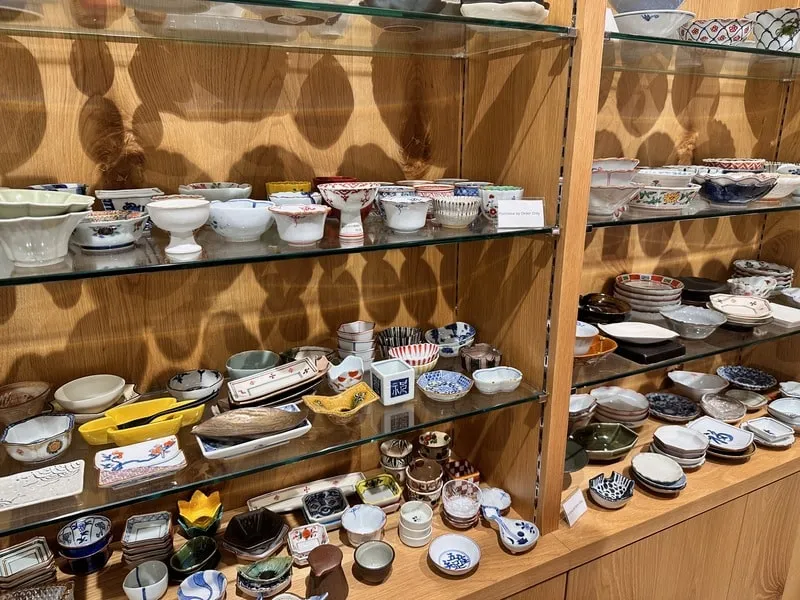
And that’s where we were greeted by Aya-san, our instructor.
Aya-san, dressed beautifully in a kimono, warmly welcomed us and showed us around. The walls were lined with stunning pottery, offering a glimpse of what we might achieve—hopefully, I thought, despite my lack of skills.
We were soon invited to sit around a gorgeous wooden table (the nicest I’ve ever seen!), where we got to choose the piece of ceramics we wanted to repair.
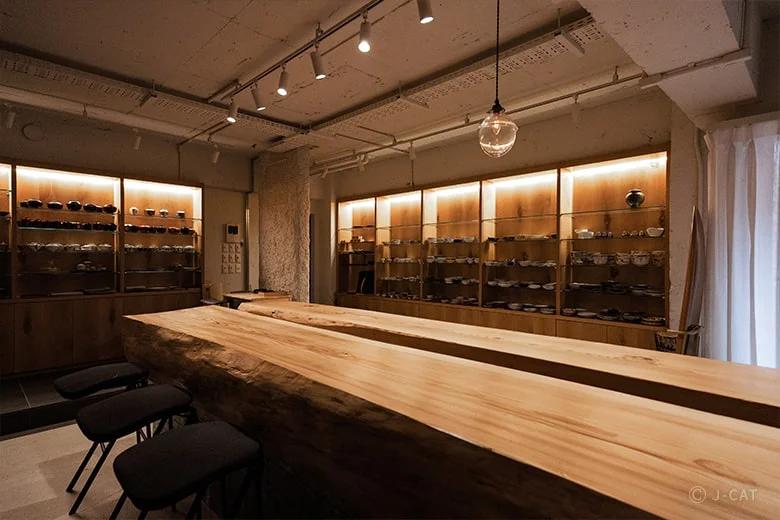
The Kintsugi Experience Process: Step-by-Step
Choosing Your Piece of Japanese Broken Pottery
If you’re attending the workshop as a couple or family, I’d recommend choosing the same item in different sizes or colors. Aya-san mentioned that traditionally, blue is often associated with men and red with women in Japanese culture. The blue items were also slightly larger than the red ones, which added to the symbolism. But since I was with a friend, I chose a red cup that I thought would be perfect for my after-lunch coffee.
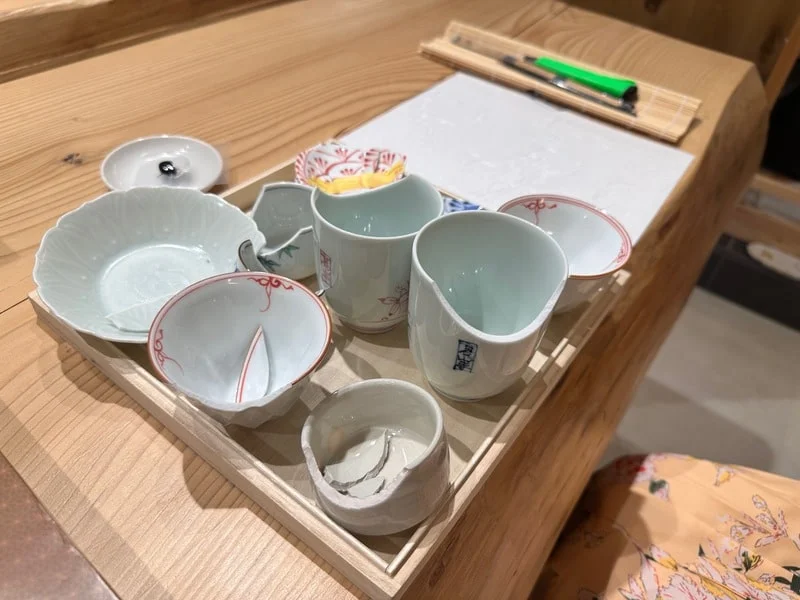
Gluing it Back Together
The first step was to sand the broken edges of the ceramic piece, which we did under Aya-san’s gentle guidance. Then we mixed the glue ourselves—no need to worry, though, as Aya-san had pre-measured everything for us. I applied the glue to the broken area and pressed the pieces together.
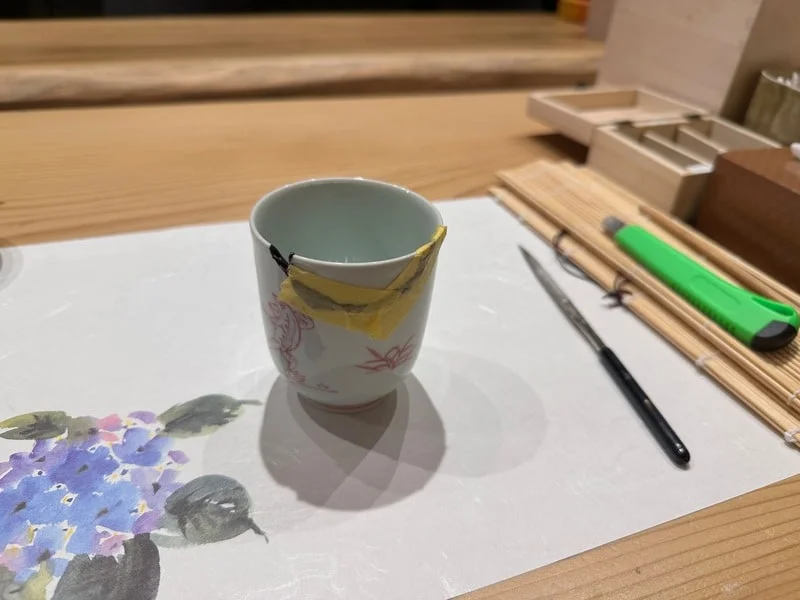
Once the glue dried, Aya-san showed us how to use a small knife to remove any excess glue around the break. It looked simple when she did it, but giving the right amount of pressure with the knife was actually challenging. But after a few tries (and Aya-san’s help), I finally got it and managed to remove all the excess glue.
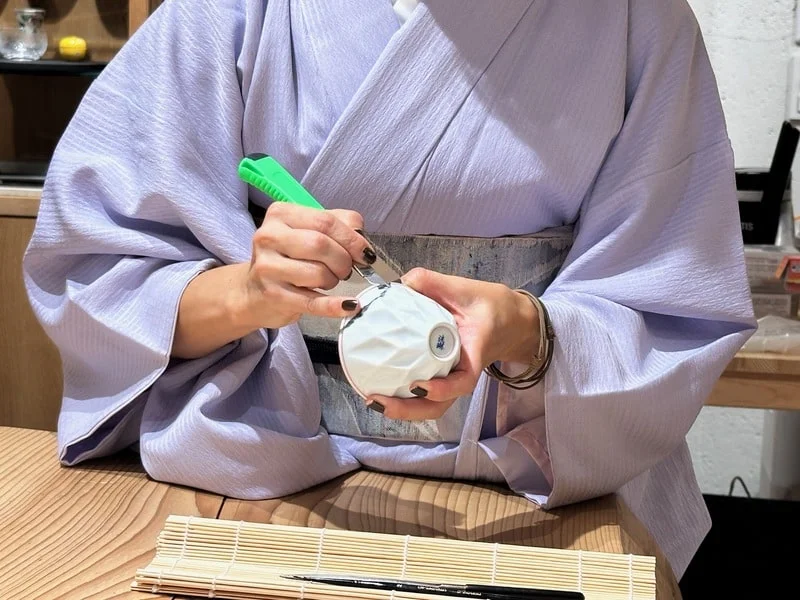
The Grind and the Putty
At this point, you might be wondering (I definitely was), what happens if the cracks are too small, or if we’ve lost a piece entirely, or it’s shattered into so many tiny fragments that there’s nothing left to glue? How do we fix that? We can’t just piece together a thousand shards!
That’s when Aya-san showed us the solution—putty. She carefully demonstrated how to apply it to the areas where parts of the ceramic were missing.
At first, the putty looked like a rough little bump sticking out of the pottery, not quite part of the piece yet. To fix that, Aya-san explained we needed to smooth it down and make it look seamless with tiny pieces of sandpaper.
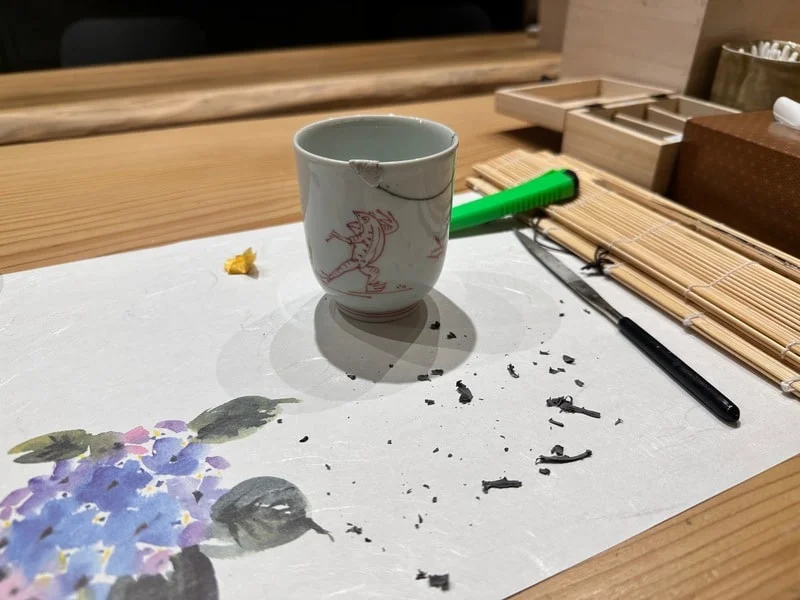
But before that, we needed to let the putty dry for about 15 minutes.
During this wait, Aya-san shared fascinating insights about the history of kintsugi, the different techniques and lacquers, and we discussed the philosophy behind the art.
Once the putty hardened, we sanded it to even out the surface between the ceramics and the putty. This was the most time-consuming step, but also the one that helped me enter that meditative state everyone talks about.
Minutes flew by. The process was simple enough—just gentle, repetitive motions—but it required patience. By running my fingers over the cup, I could feel how much of a bump was left. Each time, I could tell I was getting closer to that smooth, unified surface between the putty and the ceramics. With every pass of the sandpaper, the difference grew fainter, until my fingers could no longer detect the bump. That’s when I knew it was ready.
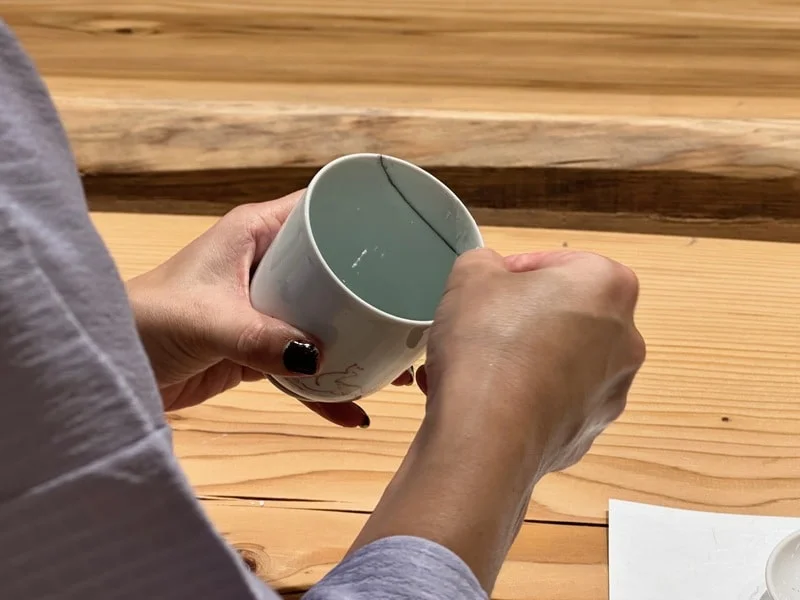
It was now time for the most iconic part of kintsugi: applying the lacquer.
Finishing Touches: The Lacquer and Gold
Using a fine brush dipped in red lacquer, I carefully traced the cracks and covered the putty with the iconic deep red lacquer. Then, I wiped off the excess with damp cotton swabs.
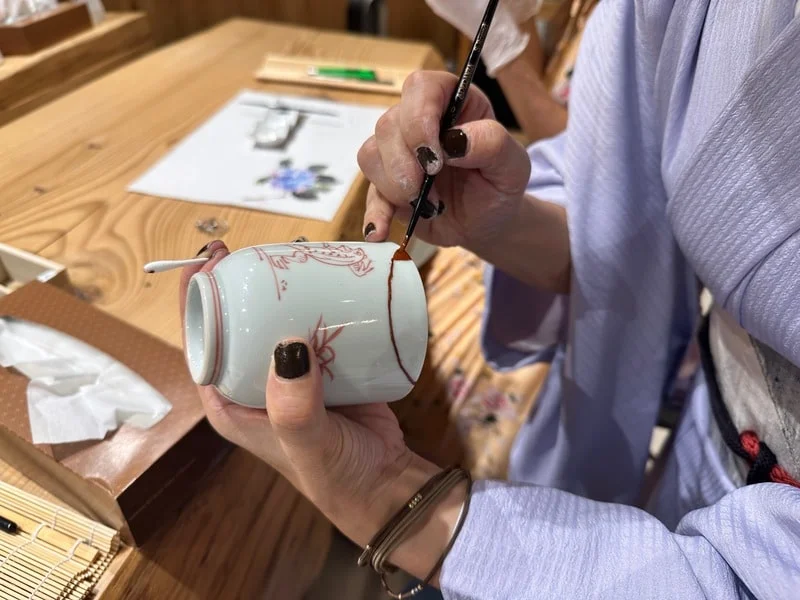
While waiting for the lacquer to dry, Aya-san served us traditional Japanese sweets and hot green tea. We chatted about her experiences, the history of the shop, and she offered us additional tips for future projects.
After the lacquer had dried, it was time for the final step: applying the dust powder to the lacquer. Aya-san offered us a choice between silver and gold powder. I went with gold, thinking it would look perfect with the red patterns on my cup.
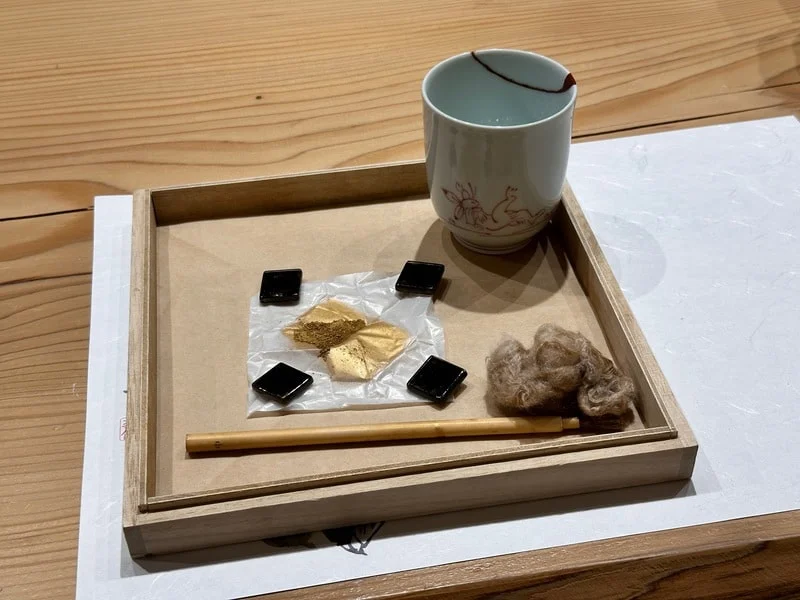
This part was simple but incredibly satisfying. Using a small ball of wool, I gently dabbed it into the gold powder and lightly brushed it over the lacquer. The powder stuck effortlessly, clinging to the lacquer and filling in the cracks. Watching the red lacquer gradually disappear beneath a shimmering layer of gold was mesmerizing. In that moment, I finally saw my finished kintsugi piece come to life—my own, unique kintsugi creation.
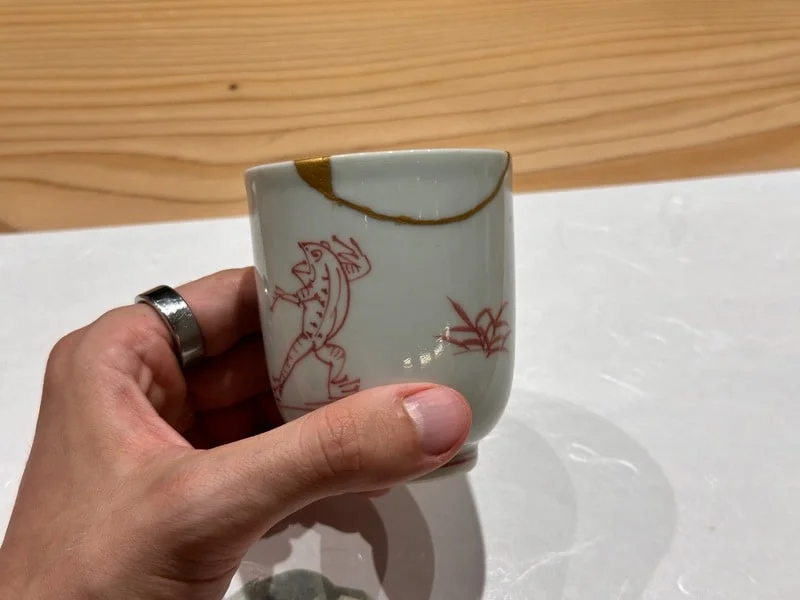
Just like that, two hours flew by. Aya-san packed our new kintsugi pieces in a sturdy wooden box, perfect for safely bringing them home (and yes, it’s airplane-friendly).
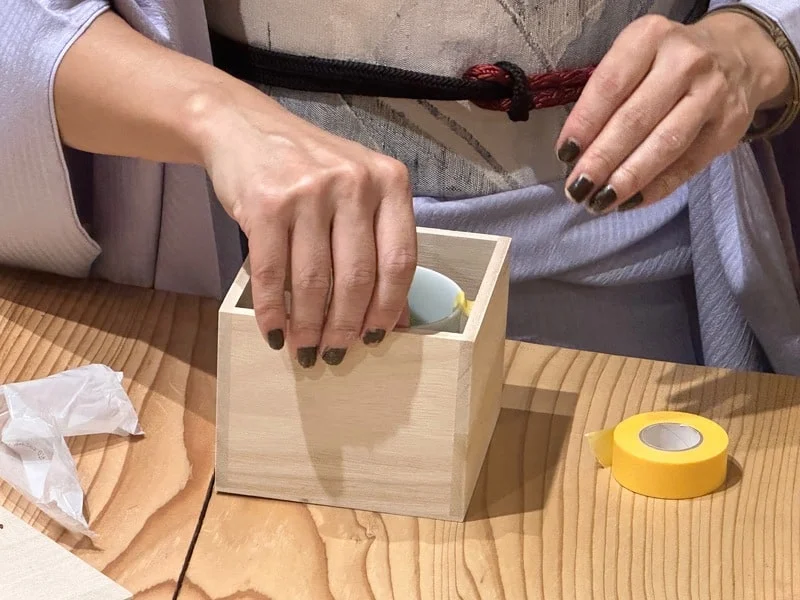
We said our warm goodbyes, and I proudly headed home, already thinking about where to display my new cup for all to see.
A Special Kintsugi Workshop in Tokyo
So, is this kintsugi experience in Tokyo worth it?
Absolutely.
It’s a really cool souvenir, made even more special because you created it yourself. Learning directly from Aya-san in such a beautiful setting made the experience unforgettable. And remember that this experience is completely private. You won’t have any strangers with you, and you can ask all the questions you want to Aya-san.
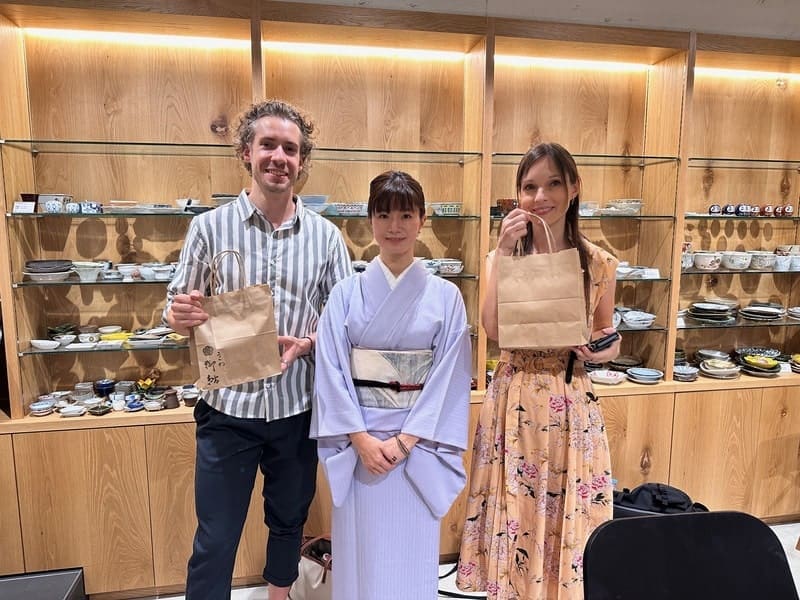
The only downside is that now I have no choice but to replace all my plain IKEA plates with something more unique to match my new cup.
By the way, you can bring your own broken pottery to repair during the kintsugi class—just send photos in advance to make sure it’s suitable.
You might also like:

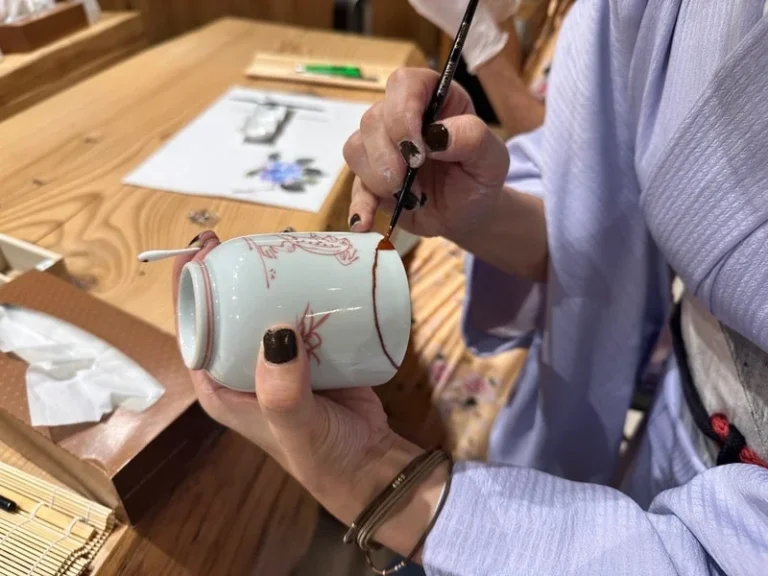
Comments are closed.